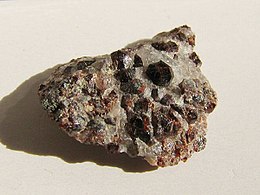| Calderite | |
|---|---|
 Calderite crystals on matrix from Sunndal Municipality Norway | |
| General | |
| Category | Silicate mineral |
| Formula | (Mn2+Ca)3(Fe3+Al)2(SiO4)3 |
| IMA symbol | Cdr [1] |
| Strunz classification | 9.AD.25 (10 ed) 8/A.08–40 (8 ed) |
| Dana classification | 51.4.3a.6 |
| Crystal system | Cubic |
| Crystal class | Hexoctahedral (m3m) H-M symbol: (4/m 3 2/m) |
| Space group | Ia3d |
| Unit cell | a = 11.819 Å; Z = 8 |
| Identification | |
| Color | brownish red to brownish yellow |
| Cleavage | None |
| Mohs scale hardness | 6.5–7.5 |
| Luster | Vitreous |
| Streak | white |
| Diaphaneity | transparent to translucent |
| Specific gravity | 3.756 |
| Optical properties | Isotropic |
| Refractive index | n = 1.872 |
| References | [2] [3] |
Calderite is a mineral in the garnet group with the chemical formula (Mn 2+, Ca)3(Fe 3+, Al)2(Si O 4)3.
It is dark reddish brown to dark yellowish in color and generally granular massive in form. [4]
It was named for geologist James Calder who worked on the geology of India. The name was first applied to a rock in manganese deposits in Katkamsandi, Hazaribagh district, Bihar and at Netra, Balaghat district, Madhya Pradesh, India. later transferred to its predominant mineral. [3] [4] In 1909 it was described as a mineral from Otjosondu, Otjozondjupa Region, Namibia. [2]